La Grenouillère
by Claude Monet
Fast Facts
- Year
- 1869
- Medium
- Oil on canvas
- Dimensions
- 74.6 × 99.7 cm
- Location
- The Metropolitan Museum of Art, New York
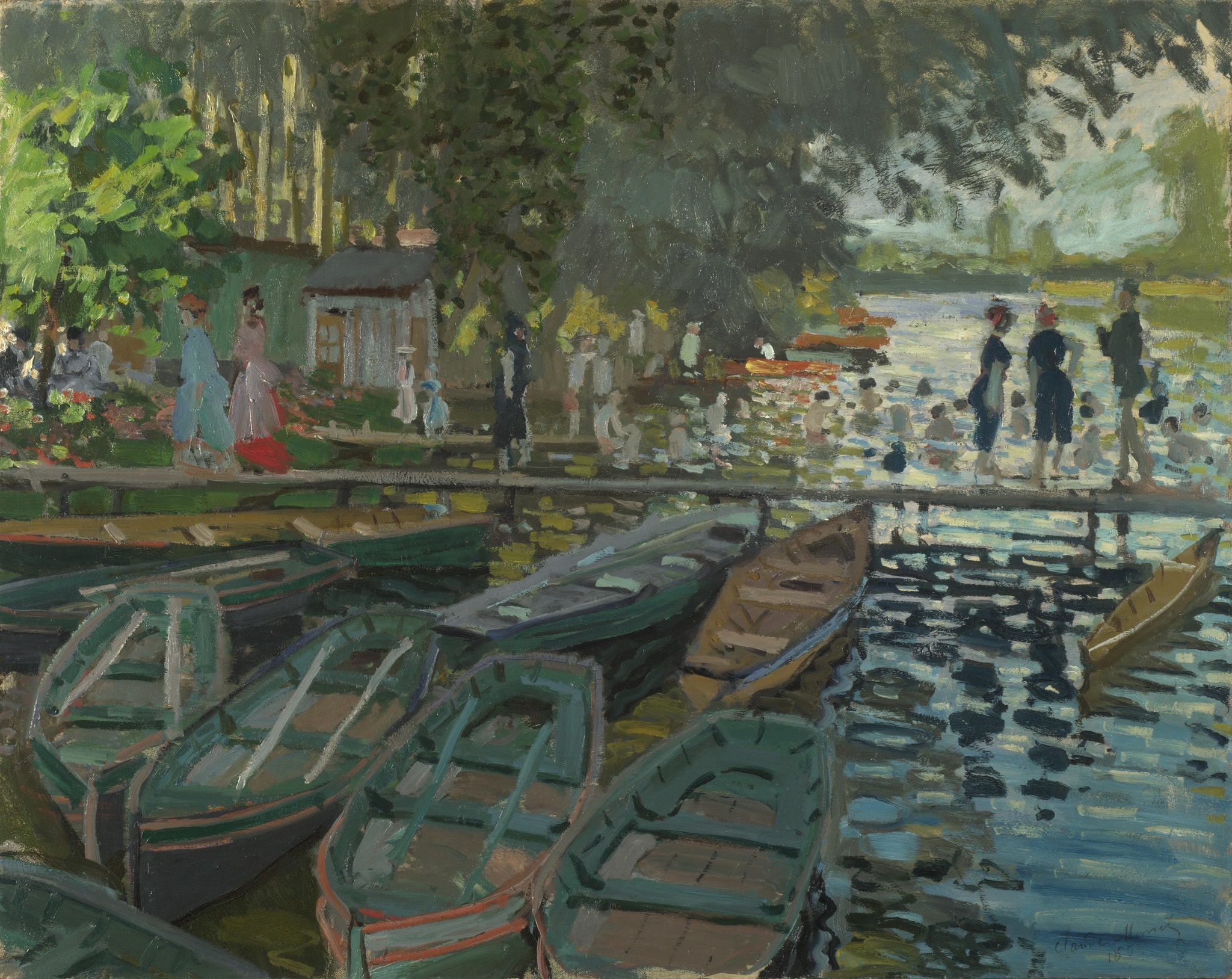
Click on any numbered symbol to learn more about its meaning
Meaning & Symbolism
The meaning of La Grenouillère lies in its declaration that modern life is experienced as flux—of class, bodies, and light—rather than as fixed forms 12. By staging shaded green rowboats against a sun-struck throng on the gangplank, Monet frames leisure as a threshold between stillness and motion, workday time and weekend escape 1. It matters because this pochade-like canvas captures the artist’s pivot toward Impressionism, where sensation outranks finish and the social fabric of the city migrates to the riverbank 2. In 1869, working en plein air and in financial difficulty, Monet condensed an entire modern world into the shimmer of the Seine 1.
Monet organizes the composition around a charged contrast: the dark, close-cropped flotilla of green rental rowboats in the foreground and the bright, teeming middle distance where bathers and strollers cluster along a narrow gangplank. This staging is not anecdotal; it asserts that modernity is movement. The hired boats, angled and overlapping, signal paid mobility and time-off, while their shaded hulls act as a visual antechamber to the glare beyond. Crossing that plank, figures pass from leafy shade into a field of broken light where water, silhouettes, and reflections merge. Monet’s short, mosaic-like strokes fracture the river into dashes of blue, jade, and cream so that contour yields to optical sensation. The result turns surface into subject: the Seine becomes a screen on which bodies, boats, and sky briefly register before slipping away 12. The site itself—La Grenouillère, with its islets, gangways, and floating guinguette—was a magnet for mixed Parisian crowds in the 1860s. Top hats, crinolines, and swimsuits shared the same platform, and Monet records this class mingling not by portraiture but by circulation: people stream toward and away from the water, pausing only as accents in a larger rhythm of crossing and looking. The little bridge that splices the canvas near the center functions as a social hinge between nature and commerce, private bodies and public spectacle. In this, Monet channels the pressures of Second Empire leisure culture that scholars identify as the core of painting “modern life” 16. Yet he refuses the finish of Salon narrative. The pochade-like handling—rapid, en plein air, and openly sketchy—asserts that the painting is about seeing in time: the water’s dazzle is rendered in staccato, “Morse-code” touches that let the viewer feel how perception flickers before it resolves 123. That wager on immediacy was strategic and historical. In 1869 Monet and Renoir set up side-by-side at the resort, chasing the same motif as studies for a larger picture Monet hoped to submit—plans stalled by hardship and refusals that year 12. Precisely because it is provisional, La Grenouillère reads like a manifesto of the instant: a claim that truth resides in transient effects, not in polished outlines. The foreground boats anchor the eye but also withhold stability; their dark mass keeps the scene from dissolving entirely, reminding us that pleasure is a commodity—a rented seat on modernity’s flow. Behind them, the crowd compressed at the water-line becomes a frieze of silhouettes, their identities unimportant next to the larger drama of liquidity and light. This is why La Grenouillère is important: it makes modern social life and modern vision inseparable, using the Seine’s glitter to show how memory and desire are written as ripples across a moment, then gone 124.Citations
- The Metropolitan Museum of Art – La Grenouillère (object page and catalogue)
- National Gallery, London – Bathers at La Grenouillère (object page)
- National Gallery Technical Bulletin 5 (1981): Monet’s 'Bathers at La Grenouillère'
- Office de Tourisme du Pays des Impressionnistes – Musée de la Grenouillère
- Met Heilbrunn Timeline of Art History: Claude Monet (1840–1926)
- T. J. Clark – The Painting of Modern Life: Paris in the Art of Manet and His Followers
- National Gallery Technical Bulletin 5 (1981) – Monet’s ‘Bathers at La Grenouillère’
- Jonathan Jones – Why Monet’s art haunts my dreams (The Guardian)
Explore Deeper with AI
Ask questions about La Grenouillère
Popular questions:
Powered by AI • Get instant insights about this artwork
Interpretations
Historical Context
Source: The Metropolitan Museum of Art; Office de Tourisme du Pays des Impressionnistes; T. J. Clark
Formal Analysis
Source: National Gallery, London; National Gallery Technical Bulletin; The Metropolitan Museum of Art
Social Commentary
Source: The Metropolitan Museum of Art; T. J. Clark
Psychological Interpretation
Source: The Metropolitan Museum of Art; National Gallery, London; The Guardian (Jonathan Jones)
Reception History
Source: National Gallery Technical Bulletin; National Gallery, London; The Metropolitan Museum of Art
Biographical
Source: The Metropolitan Museum of Art; National Gallery, London
Related Themes
About Claude Monet
More by Claude Monet

Haystacks Series by Claude Monet | Light, Time & Atmosphere
Claude Monet
Claude Monet’s <strong>Haystacks Series</strong> transforms a routine rural subject into an inquiry into <strong>light, time, and perception</strong>. In this sunset view, the stacks swell at the left while the sun burns through the gap, making the field shimmer with <strong>apricot, lilac, and blue</strong> vibrations.

The Artist's Garden at Giverny
Claude Monet (1900)
In The Artist's Garden at Giverny, Claude Monet turns his cultivated Clos Normand into a field of living color, where bands of violet <strong>irises</strong> surge toward a narrow, rose‑colored path. Broken, flickering strokes let greens, purples, and pinks mix optically so that light seems to tremble across the scene, while lilac‑toned tree trunks rhythmically guide the gaze inward <sup>[1]</sup><sup>[3]</sup>.
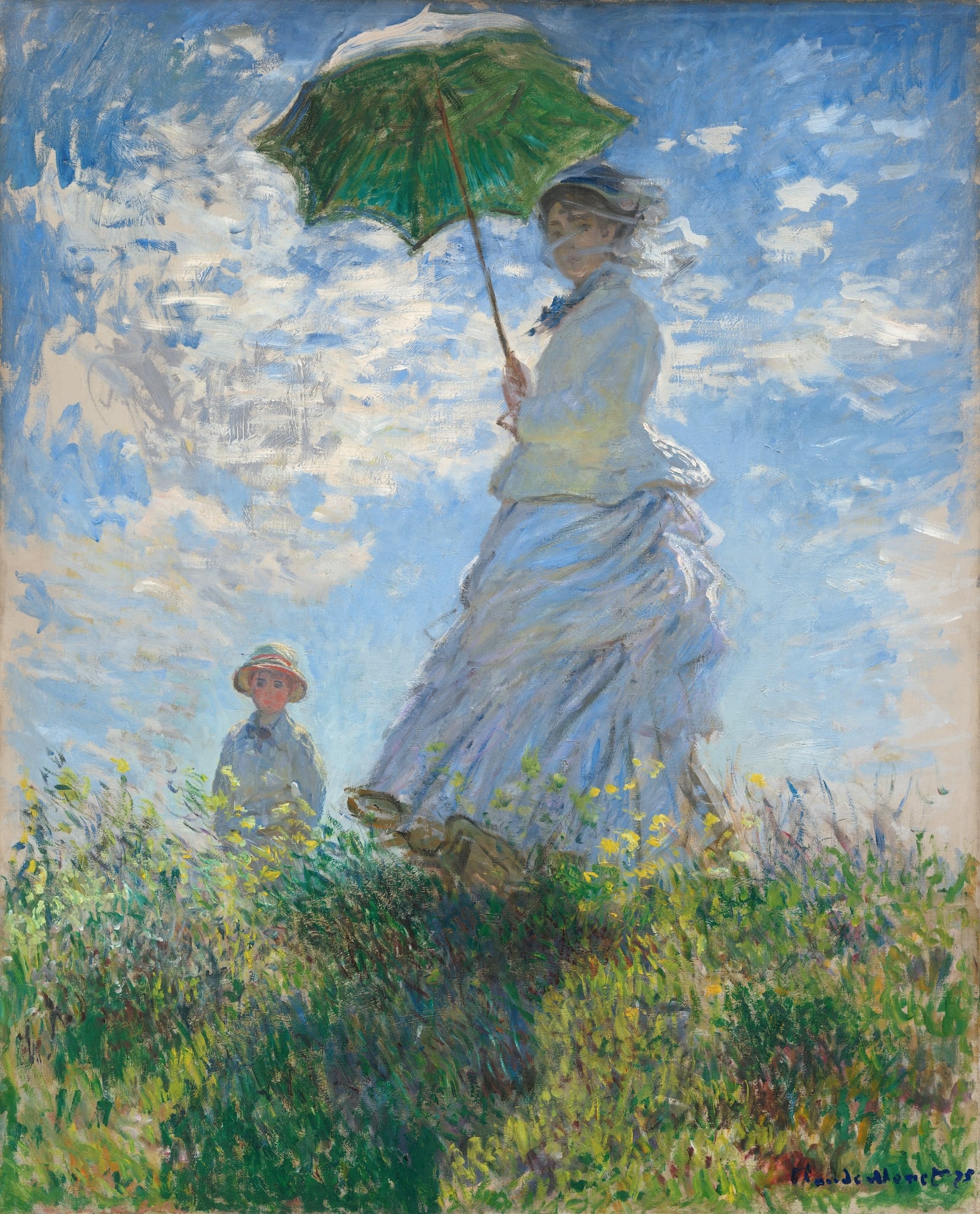
Woman with a Parasol
Claude Monet (1875)
Claude Monet’s Woman with a Parasol fixes a breezy hillside instant in high, shifting light, setting a figure beneath a <strong>green parasol</strong> against a vast, vibrating sky. The low vantage and <strong>broken brushwork</strong> merge dress, clouds, and grasses into one atmosphere, while a child at the rise anchors depth and intimacy <sup>[1]</sup>. It is a manifesto of <strong>plein-air</strong> perception—painting the sensation of air in motion rather than the contours of things <sup>[2]</sup>.
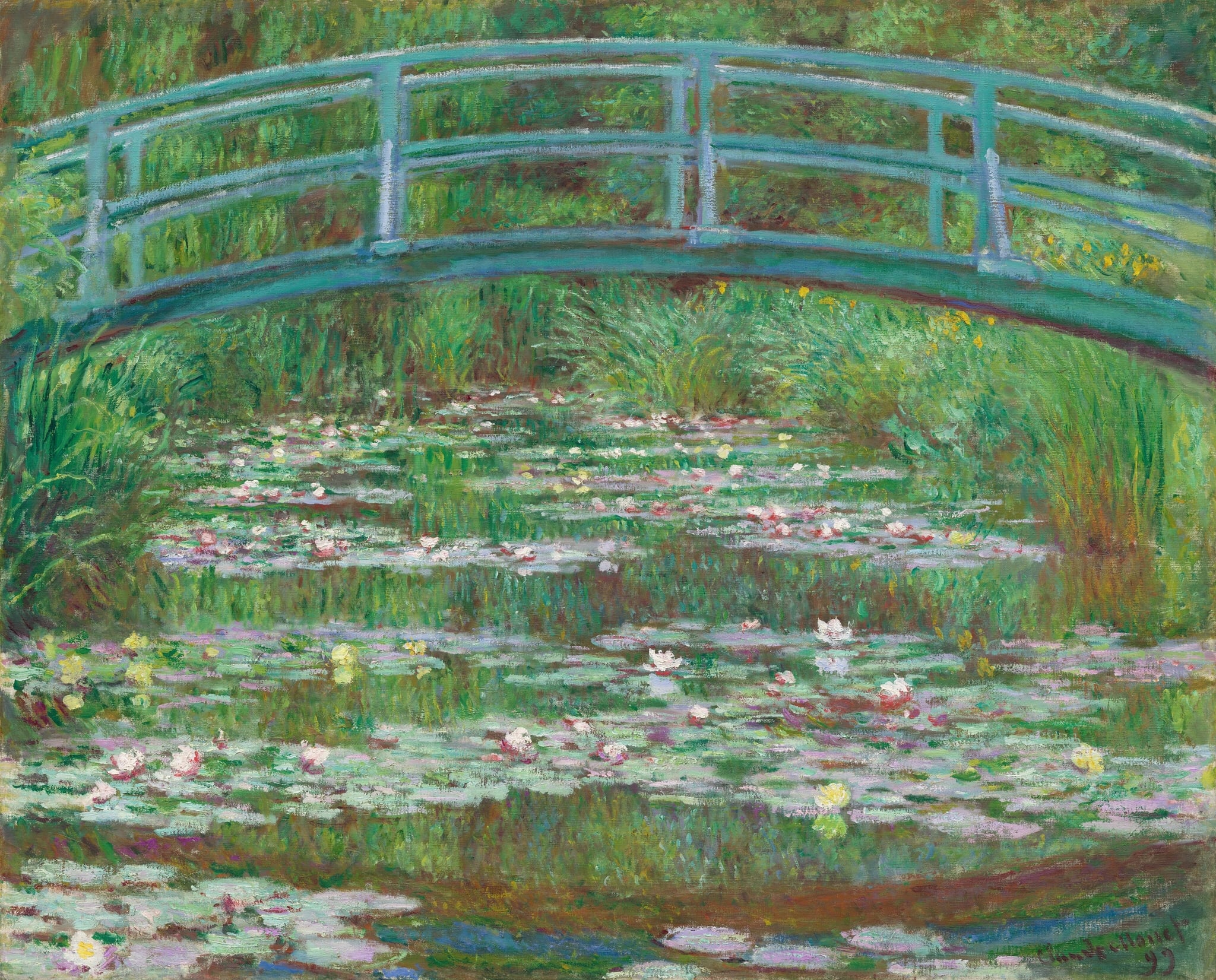
The Japanese Footbridge
Claude Monet (1899)
Claude Monet’s The Japanese Footbridge turns his Giverny garden into an <strong>immersive field of perception</strong>: a pale blue-green arc spans water crowded with lilies, while grasses and willows dissolve into vibrating greens. By eliminating the sky and anchoring the scene with the bridge, Monet makes <strong>reflection, passage, and time</strong> the picture’s true subjects <sup>[1]</sup><sup>[2]</sup>.
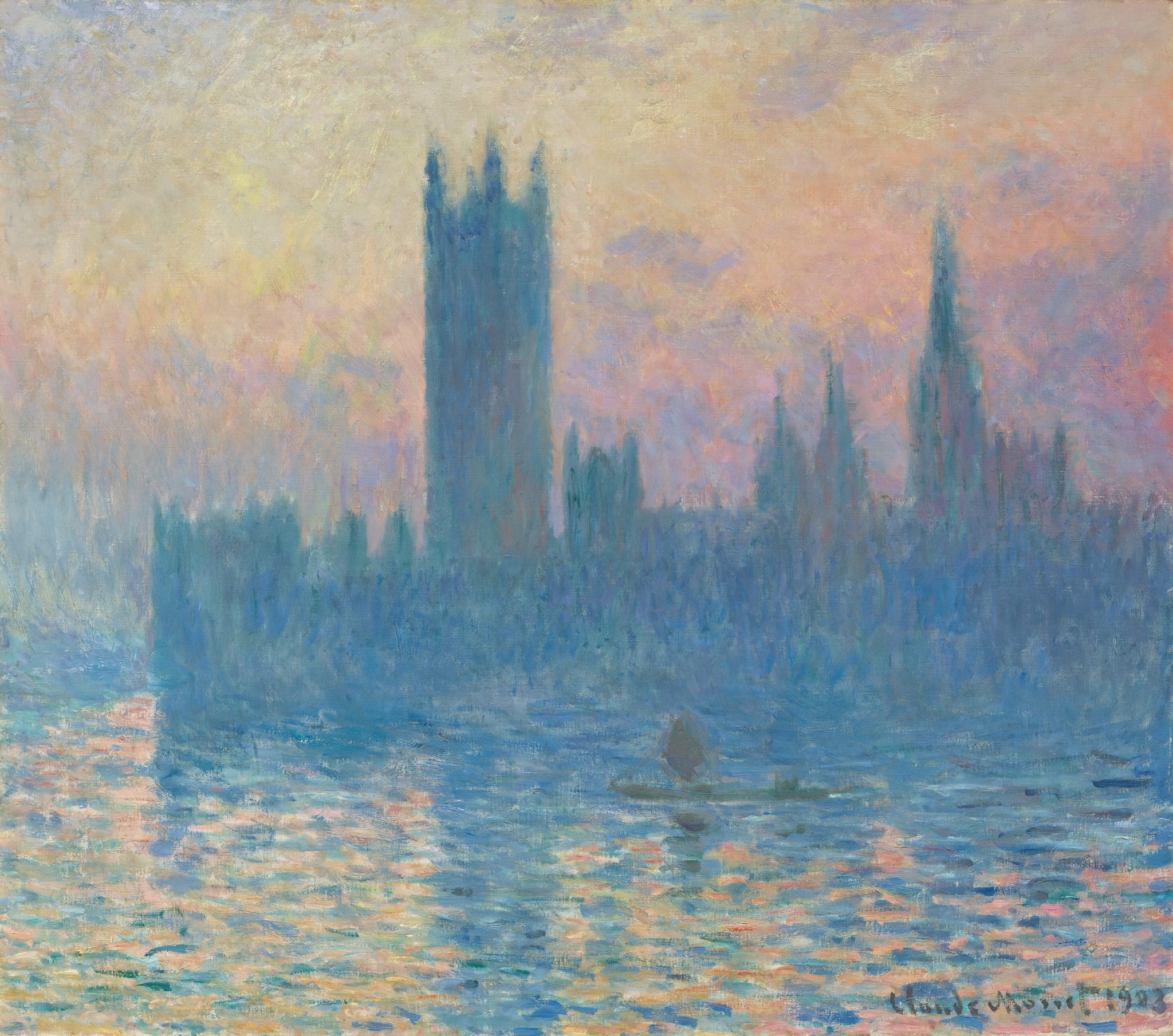
Houses of Parliament
Claude Monet (1903)
Claude Monet’s Houses of Parliament renders Westminster as a <strong>dissolving silhouette</strong> in a wash of peach, mauve, and pale gold, where stone and river are leveled by <strong>luminous fog</strong>. Short, vibrating strokes turn architecture into <strong>atmosphere</strong>, while a tiny boat anchors human scale amid the monumental scene.
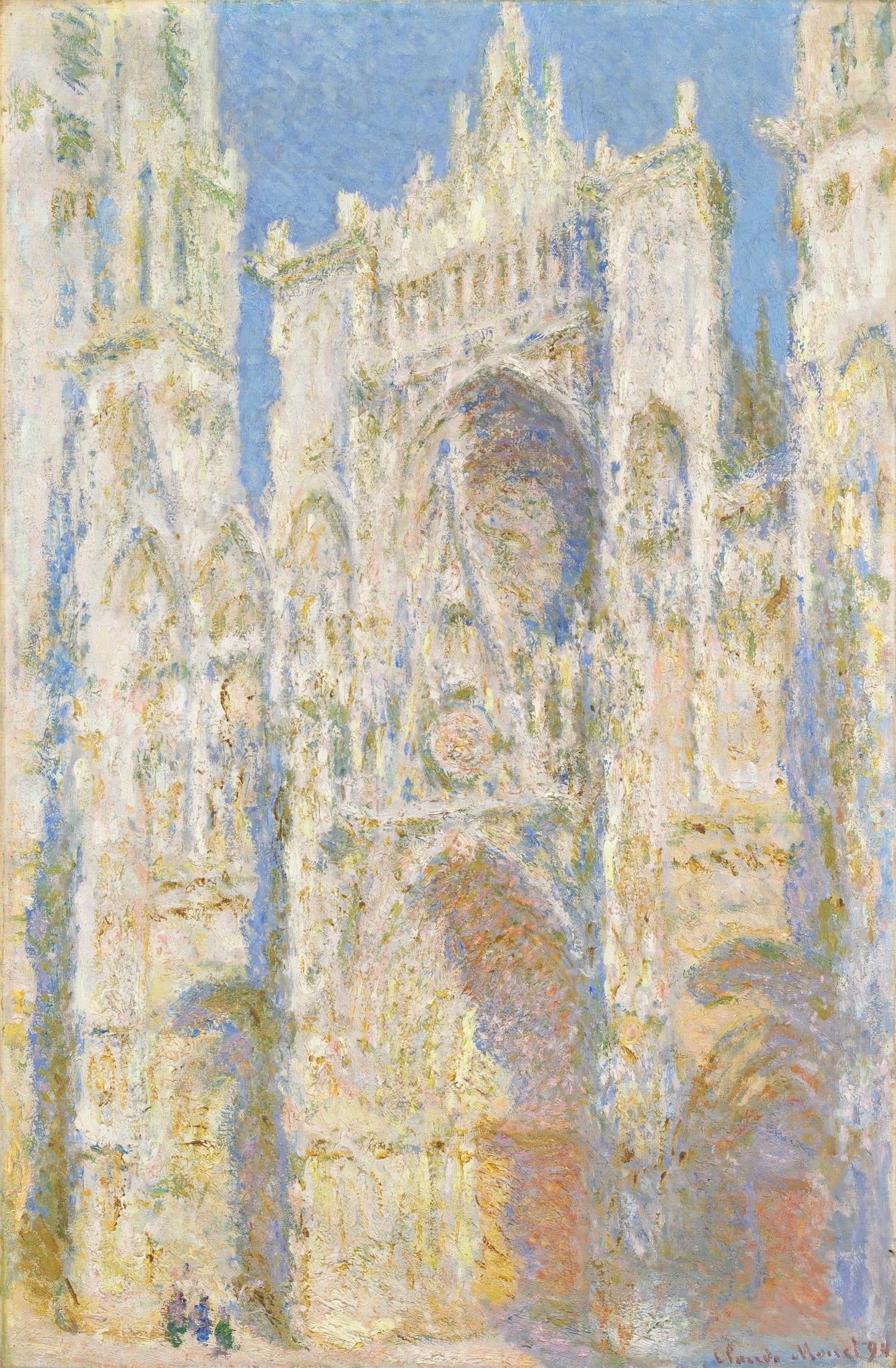
Rouen Cathedral Series
Claude Monet (1894)
Claude Monet’s Rouen Cathedral Series (1892–94) turns a Gothic monument into a laboratory of <strong>light, time, and perception</strong>. In this sunstruck façade, portals, gables, and a warm, orange-tinged rose window flicker in pearly violets and buttery yellows against a crystalline blue sky, while tiny figures at the base anchor the scale. The painting insists that <strong>light—not stone—is the true subject</strong> <sup>[1]</sup><sup>[2]</sup>.